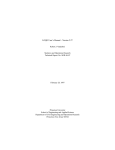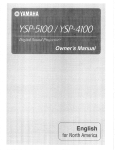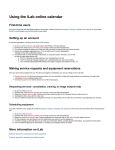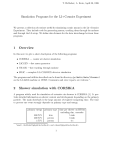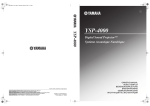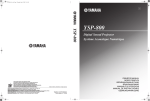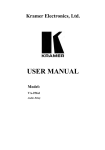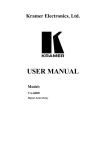Download A Short Guide to XGobi
Transcript
A Short Guide to XGobi Professor B. D. Ripley XGobi is a freeware system for dynamic graphics written by Deborah F. Swayne, Dianne Cook and Andreas Buja at Bellcore, and ported to Windows by me. This short guide does not explain all the modes of XGobi. This version of the guide describes the August 2000 release of XGobi. 1 Usage from S-PLUS The S-PLUS interface is just a wrapper function which produces files for XGobi to read. The function is xgobi, in the library xgobi, so a typical invocation is library(xgobi) xgobi(crabs[,4:8], glyph=c(12,17,22,27)[crabs.grp]) Note that the library command is only needed once per session. The row and column labels are obtained from the matrix or dataframe, but may also be supplied as arguments rowlab= and collab= respectively. Argument colors= supplies (not surprisingly) the colour assignment for each row. 2 Command layout XGobi is entirely driven by the mouse, and has a number of modes. Its appearance in Grand Tour mode is shown in figure 1. The window can be resized as a whole using the resize corners. The proportions of the bottom panel devoted to the buttons, graphics and variable selection can be adjusted by moving the tabs near the bottom of the separating lines with the LEFT mouse button (subsequently abbreviated to L, analogously M and R). Depending how your machine is set up, M may be emulated by pressing L and R together. Some buttons1 hide menus of exclusive options, which are brought up by holding down L and releasing it when the desired option is highlighted. Others have menus which are brought up by a click. All stay-up menus and windows have a Click here to dismiss panel at the bottom— use L to do so. Many buttons are toggles—click with L to highlight them (and switch the function on) and click again to switch the function off. Help is available on any feature of the command layout by clicking with R, which will bring up a help window. If the window has a scrollbar, clicking L will move the window down by the distance from the top to the mouse pointer, and clicking M will move the display to that point proportionally in the total display. Most of the major options are on the View menu. The Display button has a menu, itself mainly of toggle actions. The only action you are likely to need is Add axes which is on by default, but toggles to remove the display of the axes. I quite often deselect centring of the axes. The 1 These are shown with a text-list icon in the figure. 1 Figure 1: Screendump of XGobi in Tour mode on 6 variables, paused. File menu has an item to Print which pops up a selection box to write postscript to a file or the printer (but the latter does not work under Windows). Selecting Variables The right-hand panel selects variables. The variable name is a button which highlights if that variable is selected, and hides a menu of transformations (use L on the name). There is normally a box advising of the current functions of the buttons. The circles below the variable names have two functions. They are used to select variables (by clicking with the circle; the precise effect depends on the mode) and the line within the circle indicates the current projection of that variable axis (as a dot if it is orthogonal to the view plane). The boundary of the circle is made bolder if that variable is selected (see the figures). 3 Rotate mode The layout is somewhat different in Rotate mode; see figure 2. Three variables must be selected, by either clicking either L or M in the variables’s circle. (Initially the first three 2 variables are selected.) There are three sub-modes, corresponding to rotating about the X axis, the Y axis or an arbitrary axis (the default), and variable selection differs in each. Figure 2: Screendump of XGobi in Rotate mode. There is a speed slider which can be dragged with L or clicked with L at the desired speed of rotation. Change Direction toggles the direction of rotation. Pause is a self-explanatory toggle; Reinit resets the original set of axes. Rock causes the rotation to change direction every ten steps, so the speed slider also controls the angle of rock. Save Coeffs saves the coefficients of the current projection (in two columns, X axis then Y axis, with rows the variables in order), in a file. 3.1 Oblique axis The current target variable is marked by a small circle in the centre of its disc when the mouse pointer is the variable selection panel. Click (with either L or M) on a currently selected variable to make it the target. Click on an unselected variable to have it replace the target. In this mode think of the points in the central window as within a transparent ball. When the rotation is paused, dragging with L or M in the central panel will mimic a reversed ‘trackball’ action rotating that ball. 3.2 Y axis In this mode there are two X variables and a Y variable. One of the X variables is the target, and is used for the X axis in the initial display. Click with M on a variable’s circle to make 3 it the Y variable, and with L to make it an X variable. (The last selected X variable is the target, marked by a small circle in the centre of its disc when the mouse pointer is the variable selection panel, and it is this X variable which is replaced.) Rotation is about the Y axis, and ‘trackball’ action still works. The additional option Interpolate rocks 90◦ between the two X axes. 3.3 X axis As for Y axis, but interchange X and Y throughout. 4 Grand Tour mode This mode is used for Asimov’s (1985) grand tour and for projection pursuit. Its default operation is a continuous grand tour through the space of selected variables (or nothing if there are just two). This continually selects a random new projection in the p-dimensional space of currently selected variables, and moves continuously (by interpolation) to that new projection. When the projection is reached, another is chosen (and a slight pause may be visible). In this mode variables are selected by clicking L within the variable’s circle, and de-selected by clicking M. Any number of two or more variables can be selected, but if only two are currently selected, neither can be de-selected until a further variable is selected. The left-hand panel controls operations. The slider at the top (see figure 1) controls the speed of rotation; drag it with L, or click with L to indicate the place you want. Pause is a selfexplanatory toggle; Reinit resets the original set of axes. In Step mode, the tour stops at each new view; click L on Go to continue. If Local Scan is selected, the tour returns to the starting position after each new view. The tour is ‘checkpointed’ at each new view, and can be selectively re-played, using the Backtrack and F or B buttons. (Once Backtrack is selected, F/B selects the direction of replay. The number between the buttons indicates the last view number. The I/O button hides a menu to save the coefficients of the current projection, and read/save the checkpoint history. The Interp button hides a menu giving a choice of interpolation method. The PC Basis button transforms the variables to principal components. The variables change names to PC1, PC2, ... but axes are still displayed in the original variables. When this button is selected or de-selected the previous view is shown in the new coordinate system. Saving the coefficients in the principal components gives the coefficients of the principal components, not the original variables. (The principal components may be saved from the I/O menu.) The PC Axes button toggles showing the axes of the principal components or those of the original variables. The Section button switches to a section tour. Points not within a tolerance Eps (set by a slider) of the current section hyperplane are shown as a single pixel point. 4 Projection Pursuit tours Selecting the ProjPrst button also selects principal component basis (necessary to ‘sphere’ the data) and brings up another window which tracks the PP index as the tour progresses. Which index is selected from a menu hidden on the PP Index button, and this will have a slider indicating the number of terms in the polynomial or bandwidth of the kernel density estimate as appropriate. The indices are described in the help for that button; be warned that calculation of the Friedman-Tukey and Entropy indices seems very slow for large datasets. N.B. No optimization is done until the Optimz button is selected. This will perform a (rough) gradient ascent when selecting new projections, and stop when a local maximum appears to have been found. Allowing the tour to proceed randomly between sessions of optimization may reveal other local maxima. 5 Enhancing plots Scale Select the Scale item on the View menu at any time when the view is stationary. The view can be dragged with L, and stretched with M. There are also arrow buttons to perform these shifts. The Stdize view button hides a menu controlling how variables are scaled. There are three possibilities. The default is to rescale to [0, 1]. Other options are to rescale to mean zero, largest distance one or to median zero, largest distance one. Brush Select the Brush item on the View menu at any time when the view is stationary. Within the view the brush size can be changed by dragging with M. Brushing is performed by dragging the brush outline (a rectangle) with L. (The rectangle can be moved without brushing by deselecting Brush on.) To brush, a colour or glyph (symbol) or both must the selected from the hidden menus on the Color and Glyph buttons. (The brush rectangle changes to the currently selected brushing colour.) The effect can be Persistent, Transient or Undo by selecting (with L) the appropriate button. There are two erase buttons. The top one changes the effect of brushing to that of erasing points. The lower button hides a menu which will restore erased points, swap erased and non-erased points, and so on. Reset hides a menu of reset actions. Hide or Exclude allows a subset of the data to be selected in various ways; see its pop-up box. Identify Selectthe Identify item on the View menu at any time when the view is stationary. Moving the pointer over the view labels (by the row label) the nearest point. Clicking L makes the 5 currently displayed label sticky (persistent). Sticky labels will be preserved in future rotations or tours. 6 References There is a user manual, Swayne, D.F., Cook, D. and Buja A. (1991) User’s Manual for XGobi, a Dynamic Graphics Program for Data Analysis Implemented in the X Window System (Version 2), Bellcore Technical Memorandum TM ARH-020368. but it is several versions of XGobi out of date and so rather confusing. Background references for dynamic graphics and projection pursuit include: Asimov, D. (1985) The grand tour: a tool for viewing multidimensional data. SIAM J. Sci. Stat. Comp. 6, 128–143. Cleveland, W.S. and McGill, M.E. (1988) Dynamic Graphics for Statistics. Wadsworth & Brooks/Cole. Cook, D., Buja, A. and Cabrera, J. (1991) Direction and motion control in the grand tour. In Proc. 23rd Symp. Inter. Comput. Sci. Statist. (ed E. Keramidas), Interface Foundation of North America. Friedman, J.H. (1987) Exploratory projection pursuit. J. Amer. Statist. Assoc. 82, 249–266. Friedman, J.H. and Tukey, J.W. (1974) A projection pursuit algorithm for exploratory data analysis. IEEE Trans. Comput. 23, 881–889. Hall, P. (1989) Polynomial projection pursuit. Ann. Statist. 17, 598–605. Huber, P. (1985) Projection pursuit (with discussion). Ann. Statist. 13, 435–525. Jones, M.C. and Sibson, R. (1987) What is projection pursuit (with discussion). J. Roy. Statist. Soc. A 150, 1–36. Sun, J. (1991) Significance levels in exploratory projection pursuit. Biometrika 78, 759–769. Fuller details of many of the projection pursuit indices used can be found in: Cook, D., Buja, A. and Cabrera, J. (1993) Projection pursuit indices based on orthonormal function expansions. J. Comput. Graph. Statist. 3, 225–250. 6 Figure 3: Screendump of XGobi in Tour mode on 4 variables, after a projection pursuit optimization. The projection pursuit window has been positioned below the main window. 7







